
by Jeremy Potter, Expedition Coordinator, NOAA Office of Ocean Exploration and Research
August 3, 2010
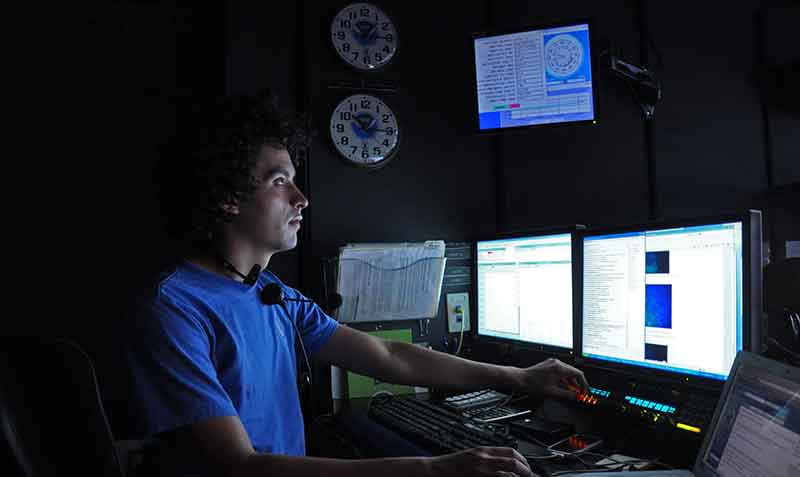
Santiago Herrera, one of Tim Shank's doctoral students with the Massachusetts Institute of Technology-Woods Hole Oceanographic Institution joint program, has been aboard NOAA Ship Okeanos Explorer during the INDEX-SATAL 2010 expedition. Image courtesy of the Woods Hole Oceanographic Institution. Download larger version (jpg, 2.7 MB).
Someone pulled out a thread on the fabric of time and space. At least that’s how it feels to be associated with this expedition. While NOAA Ship Okeanos Explorer is operating in Indonesian waters, satellite and high-speed Internet pathways, AKA “telepresence,” enables shore-side scientist participation across the globe.
Telepresence provides for ship-to-shore communication in real time both with video and audio. The ship broadcasts three live high-definition-quality video feeds via satellite. Participants in the shore-side Exploration Command Centers (ECCs) can see these feeds, as can anyone else on Internet 2. Shipboard technicians running the system can send video to shore from any of the 18 cameras on the ship and even several of the computer screens. Also critical is the intercom system which directly links everyone by voice. If I just press a button on the intercom unit in the Jakarta ECC and speak into the microphone, I can have a conversation with someone on the ship or someone in Seattle.
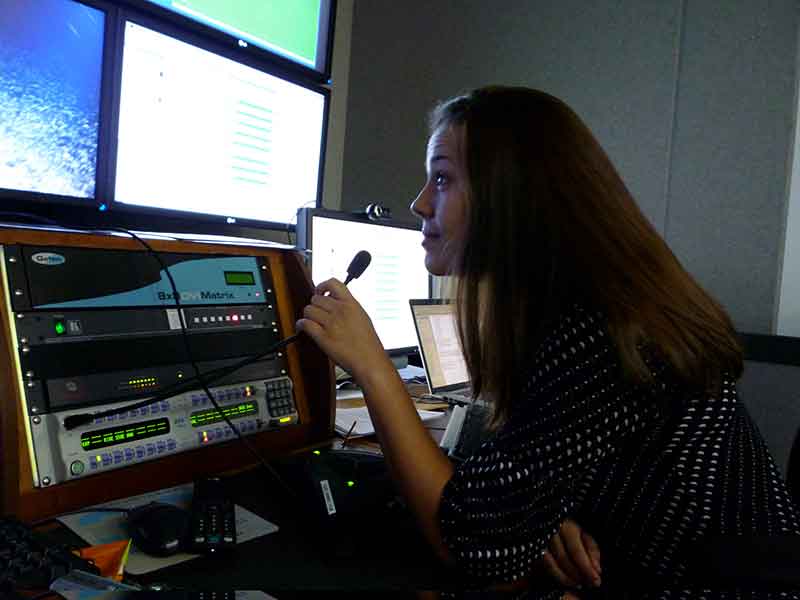
Eleanor Bors, one of Tim Shank's doctoral students with the Massachusetts Institute of Technology-Woods Hole Oceanographic Institution joint program, has been based at the Seattle ECC during the INDEX-SATAL 2010 expedition. Image courtesy of the Woods Hole Oceanographic Institution. Download larger version (jpg, 4.9 MB).
Over the last two months, we’ve learned many of the strengths and challenges associated with telepresence. One of the particularly exciting developments has been the adaptability of scientists to use complementary technology. At the very beginning of this expedition, all of the shore-side scientists were participating from the ECCs in Jakarta, Indonesia, and Seattle, Washington. Since then, the team found ways to tap into the Internet 2 feeds from their universities to see the video. Add the final ingredient, a simple conference phone call in the Seattle ECC and suddenly scientists at the Woods Hole Oceanographic Institution (WHOI) and the University of Victoria, British Columbia are ‘directly’ connected as well.
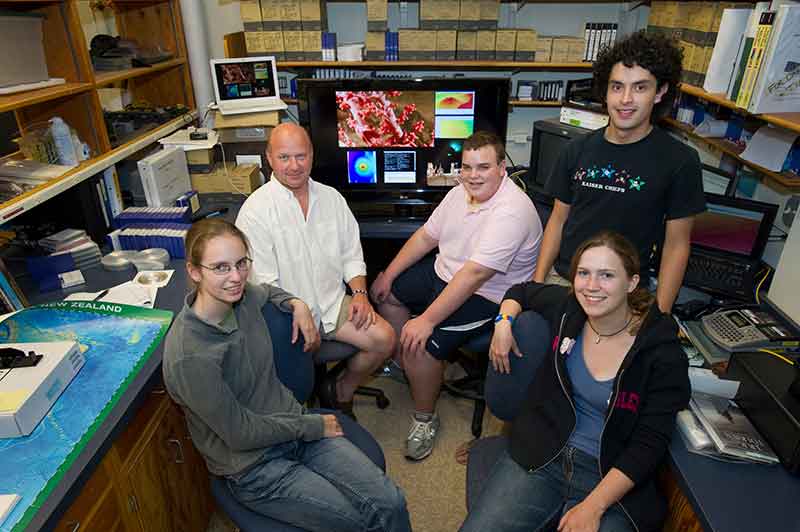
Lead Scientist, Tim Shank, with students, interns, and volunteers. During the INDEX-SATAL 2010 expedition, Tim and his graduate students and interns are distributed in four geographic locations across the globe, yet all participate in operations at the same time. Left to right: Elizabeth Sibert, Tim Shank, Will Hallisey, Santiago Herrera, and Catriona Munro. Image courtesy of the Woods Hole Oceanographic Institution. Download larger version (jpg, 2.4 MB).
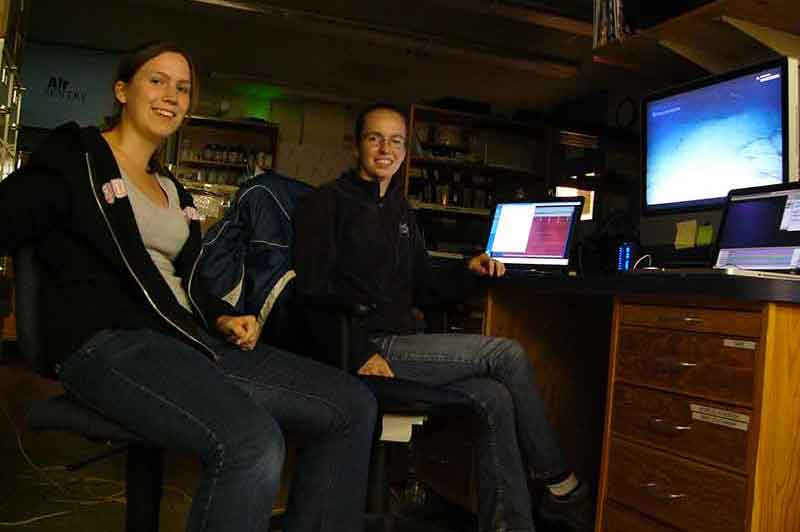
Volunteer intern, Catriona Munro, and summer fellow, Elizabeth Sibert, take part in the INDEX-SATAL 2010 expedition from Woods Hole Oceanographic Institution (Woods Hole, Massachusetts). The team accessed Okeanos Explorer's video feed via Internet 2 and communicated with scientists ashore and at sea via a conference call and utilization of a real-time, text-based collaboration tool referred to as the 'Eventlog' (essentially a group chat room). Image courtesy of the Woods Hole Oceanographic Institution. Download larger version (jpg, 2.7 MB).
Tim Shank, the lead shore-side scientist for Leg III of the expedition, recently took it one step further. For at least a few days, Tim worked out of a hotel room in South Carolina by using screen sharing software to view the video feed at WHOI from his laptop. Though he could only ‘see’ one of the three feeds and at a reduced quality, it still shows the power of what is now possible.
One of the previously underestimated challenges is the difficulty of working across so many time zones. Trying to coordinate with people onboard, in Jakarta, the Pacific Northwest, and East Coast of the United States is enough to drive someone crazy. Since local ship time is exactly 12 hours ahead of the U.S. Eastern time zone, it’s extremely difficult to even find a good time to talk. Onboard personnel, exhausted from a full day’s work, are ready to fall asleep when the United States wakes up and email starts ‘flying.’ Scientists back in the States are up into the wee hours of the morning for ROV dives and can only catch a brief respite before their day begins.
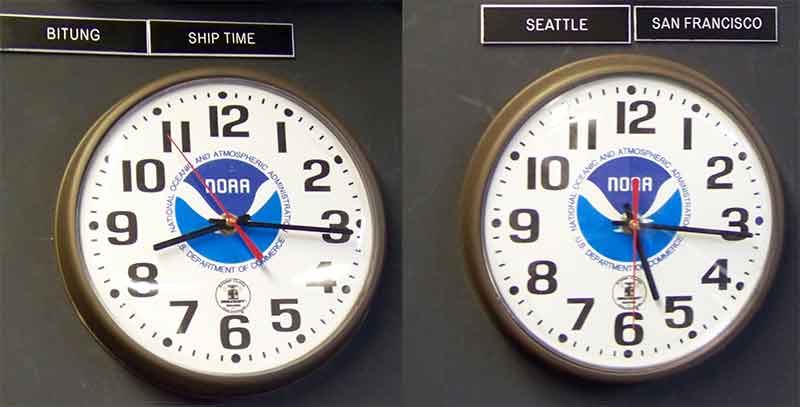
A large digital clock in Okeanos Explorer’s control room always displays the current time in UTC. Data from sensors and equipment on board the ship are always logged in UTC so operations on board the ship, regardless of the ship’s geographic location, can later be correlated to, for example, comments made in the Eventlog. Image courtesy of the NOAA Office of Ocean Exploration and Research, INDEX-SATAL 2010. Download larger version (jpg, 1.5 MB).
Besides all of the undersea ‘finds’ from this expedition, by the time this is over, I expect well also have a very well-documented telepresence version of ‘jet-lag’.